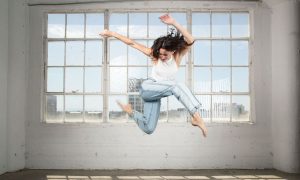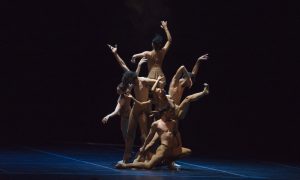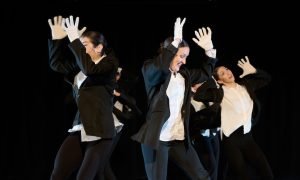We always hear about the importance of what you eat, but could when you eat be just as important?
By Emily C. Harrison MS, RD, LD.
What’s the secret for dancing stronger, improving body composition, building muscle, having more endurance, and improving performance? Energy Balance. Backed by sound science, the concept of energy balance is all about timing healthy meals and snacks to work for you. Managing your energy balance can even play an important role in injury prevention.
What is Energy Balance?
Energy Balance is eating exactly the right amount of fuel for the activity you are about to do. It is meeting and adjusting your body’s energy (calorie) needs as they change throughout the day depending on how hard you are working. Let’s say you are going on a road trip….
Which option would you choose?
- Ok car, I’m not going to give you any fuel now, but when we get there I’ll give you all the fuel you need?
- Ok, car, I’m going to give you all the fuel you need for the trip now, but you have to figure out where to store it?
- Or…Ok car, I’ll fuel you up now for the next 2-3 hours and then I’ll stop and fuel you up again when you need it?
Obviously, we should choose option 3, but all too often dancers choose option 1 or 2. Providing enough calories from healthy foods at carefully planned intervals when dancing gives the body the fuel it needs to perform its best. When athletes have enough fuel, preferably from carbohydrates, they have been shown to have higher jumps and more endurance. Also, when dancers eat regular healthy snacks they tend to not overeat later. If a dancer gets extremely hungry because he or she hasn’t eaten in a while, he or she tends to overeat more than needed within a certain time frame and those extra calories get stored. Some is stored as a much needed type of fuel called glycogen which is easy to access when dancing the next day, but some is converted to body fat. This is why eating smaller more frequent meals not only leads to better performance but also to more muscle and less fat. We all know that working in an aesthetic art form means that we have to be judicious about what we eat, but planning meals and snacks wisely throughout the day can actually lead to better, stronger muscles and lower body fat percentage.
Whether someone dances two hours a day or ten, in order to perform their best they have to provide exactly the right amount of fuel to their system at the right time. Going for too long without eating can backfire by forcing the body to come up with fuel from somewhere. When running on empty, the body breaks down muscle tissue and converts it into a type of fuel that the muscles and brain can use.
There are several problems with the all too common dancer strategy of not eating before and during classes/rehearsals/shows and waiting until later to eat: The body lowers your metabolic rate to adjust, the body burns muscle for fuel and thus makes you weaker and more prone to injury. The brain has a harder time concentrating with no fuel, so choreography is harder to pick up and ultimately you end up with a higher body fat percentage and less muscle. Eating a small snack would have been a much more efficient source of fuel.
Here are my top 10 energy balance tips.
- Eat breakfast!
- Have a 100-250 calorie morning snack especially if you have rehearsals
- Provide some calories every 2-3 hours during your day
- Eat smaller more frequent meals
- Plan a 100-250 calorie afternoon snack around 3:00-4:00pm to stave off hunger
- Eat a reasonable dinner with carbohydrate, protein, and some healthy fats
- Do eat after dancing, but don’t overdo nighttime snacking
- Hydrate, hydrate, hydrate all day
- Sip on a sports drink if dancing for a long time and eating isn’t possible
- Focus on fruits, veggies, and whole grains when meal/ snack planning – these carbs are good!
Pack a snack in your dance bag like a granola bar, banana, dried fruit, nuts, and whole grain crackers and peanut butter or make a wrap with hummus, veggies and rice. Make some pasta salad with whole grain pasta, black beans, tomatoes, corn, and red peppers – yum! Planning is the key to making healthy food convenient.
Want to know more?
Here is some additional info:
Working muscles require calories in order to provide enough readily available energy in the form of adenosine triphosphate (ATP) and creatine phosphate (CP) particularly for the short, high intensity bursts of activity that we dancers do in class and in performance. Longer bouts of exercise (Swan Lake for example) require the use of stored glycogen and fats. The body adjusts what it uses for energy based on the intensity of work and level of training. Providing calories before exercising preferably from carbohydrates, results in better performance and helps preserve muscle mass. For longer shows, sipping on a sports drink or having a granola bar during intermission will help dancers finish strongly.
According to the American College of Sports Medicine, “Inadequate energy intakes can result in loss of muscle mass, menstrual dysfunction, loss or failure to gain bone density, an increased rate of fatigue, injury, and illness”. Injuries or illness can greatly affect a dancer’s training. Dancers can have fewer injuries and illnesses by managing their energy balance.
Emily Harrison
 Emily Cook Harrison MS, RD, LD
Emily Cook Harrison MS, RD, LD
Emily is a registered dietitian and holds both a bachelor’s and master’s degree in nutrition from Georgia State University. Her master’s thesis research was on elite level ballet dancers and nutrition and she has experience providing nutrition services for weight management, sports nutrition, disordered eating, disease prevention, and food allergies. Emily was a professional dancer for eleven years with the Atlanta Ballet and several other companies. She is a dance educator and the mother of two young children. She now runs the Centre for Dance Nutrition and Healthy Lifestyles. She can be reached at emily@dancernutrition.com www.dancernutrition.com
Top photo: © Ivan Mikhaylov | Dreamstime.com
Published by Dance Informa digital dance magazine – dance news, dance auditions & dance events for the professional dancer, dance teacher and dance students.















